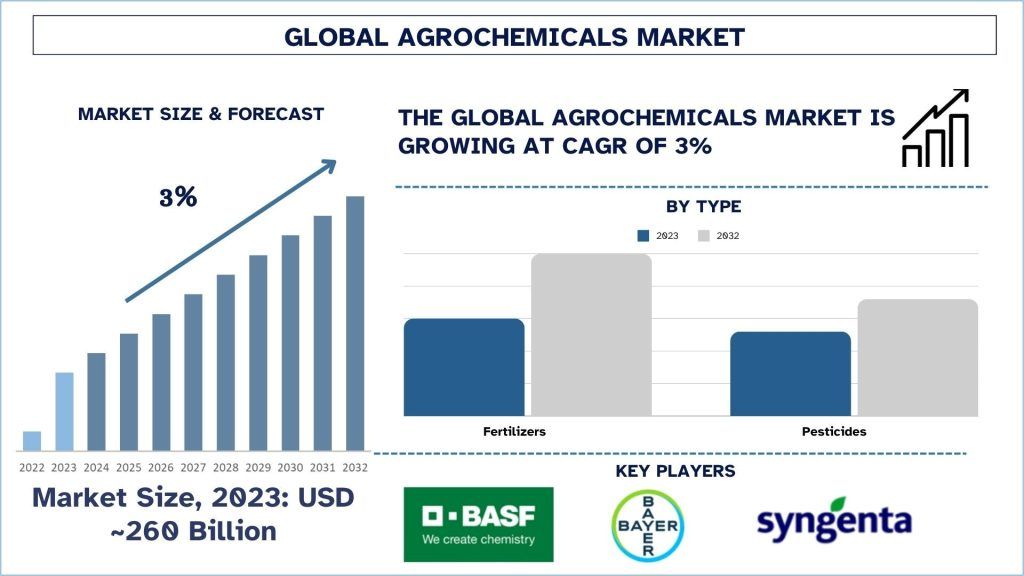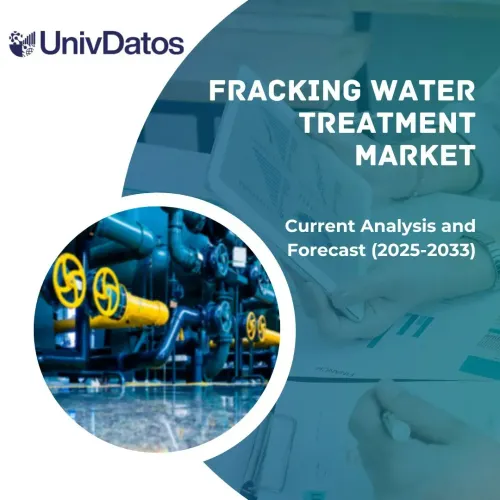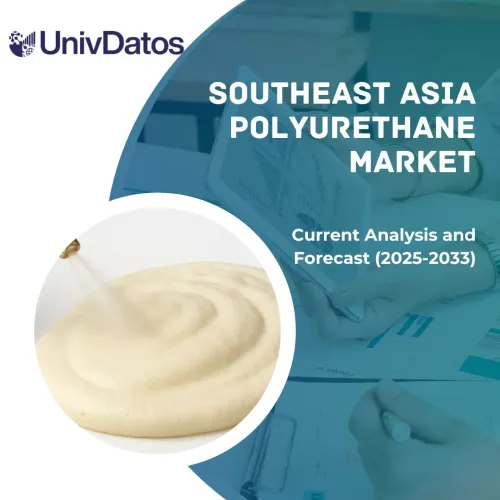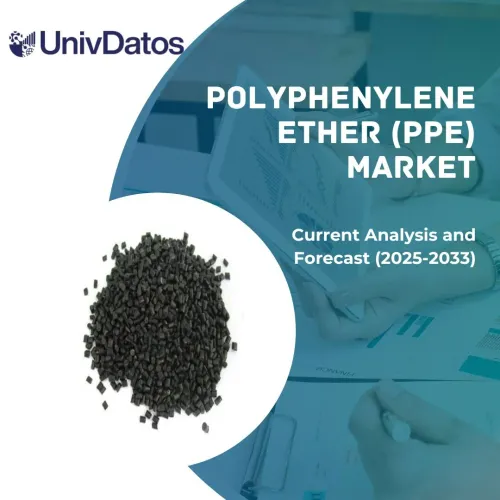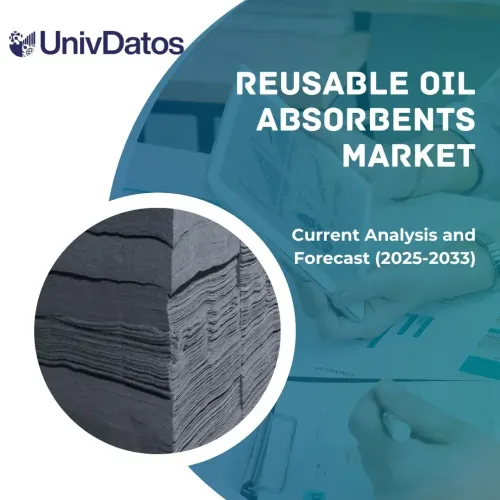- Home
- About Us
- Industry
- Services
- Reading
- Contact Us
Agrochemical Market: Current Analysis and Forecast (2024-2032)
Emphasis on Type [Fertilizers (Nitrogen, Phosphatic, and Potassic) and Pesticides (Fungicides, Herbicides, Insecticides, and Others)]; Crop (Cereals and Grains, Oilseeds and Pulses, Fruits and Vegetables, and Others); and Region and Country
Agrochemicals Market Size & Forecast
The Agrochemicals market was valued at approximately USD 260 Billion in 2023 and is expected to grow at a substantial CAGR of around 3% during the forecast period (2024-2032) owing to the rising adoption of renewable energy.
Agrochemicals Market Analysis
The term agrochemicals is used to describe a wide category of chemical products, which is employed in agricultural practices with a view of boosting production, fighting diseases and pests as well as improving soil productivity. This group of inputs comprises fertilizers, pest control agents (herbicides, insecticides, fungicides) plant growth stimulants and moderators, and soil conditioners. As external forces affecting crops diseases, pests, and other environmental risks, agrochemicals assist farmers in meeting the present food demand through efficient farming without compromising the produce.
For companies to expand in the agrochemical industry, the emphasis shifts to innovation through technology to develop environmentally friendly agrochemical inputs such as biopesticides and biofertilizers. They have also developed precision agriculture technologies that increase the applicability and efficiency of agrochemical products with the least chance of harming the environment. In addition, the use of strategic alliances and partnerships with tech firms to digital solutions to tackle issues that affect farmers as well as penetration to new markets are the main future avenues to grow and satisfy farmers’ needs. For instance, on December 15, 2023, Sumitomo planned to build a new pesticide plant in western Gujarat, India, and is expected to acquire about 50 acres of land to produce technical. This is the company’s third plant in India and will increase its annual production capacity by 80%.
Agrochemicals Market Trends
This section discusses the key market trends influencing the various segments of the Agrochemicals market as identified by our research experts.
Shift Towards Biologicals Transform Agrochemicals Industry
The rise of biologicals in the agrochemical market is on account of growing customer awareness of the sustainable and eco-friendly mode of farming. Biopesticides and biofertilizers are derived from natural materials to overcome the challenges associated with and limitations of synthetic chemicals. Such change is further backed by regulatory compliance and governments encouraging the use of safer agriculture inputs. Biofertilizers improve the physical properties and fertility of the soil as well as the germinal capacity, as they raise crop resistance and productiveness. Furthermore, with the increased use of pesticide and pest-resistant crops, biologicals are increasingly following as core tools within IPM and modern sustainable farming practices. The development of new biological products leads to the generation of growth opportunities for firms concerning the funding of research.

North America is expected to grow the market.
North America contributes the most to the growth of the agrochemical industry owing to the enhanced use of technology in farming. The region produces a wide range of crops in large arable land areas, hence croppers seek efficient agrochemicals to boost production and control pests and diseases. Moreover, the diversity of consumers, customers, and the public demanding sustainable farming is forcing farmers to adopt eco-friendly agrochemicals like Biopesticides and Biofertilizers. Subsidies received from the government and research funding motivate the companies to make innovations and produce new products. Moreover, strong and competitively dominant agrochemical corporations and industries are present in the United States hence encouraging competition and growth of the research aspect in the development of the product. Precision agriculture also increases the effectiveness of agrochemical applications, which is, rationalizes the use of resources.
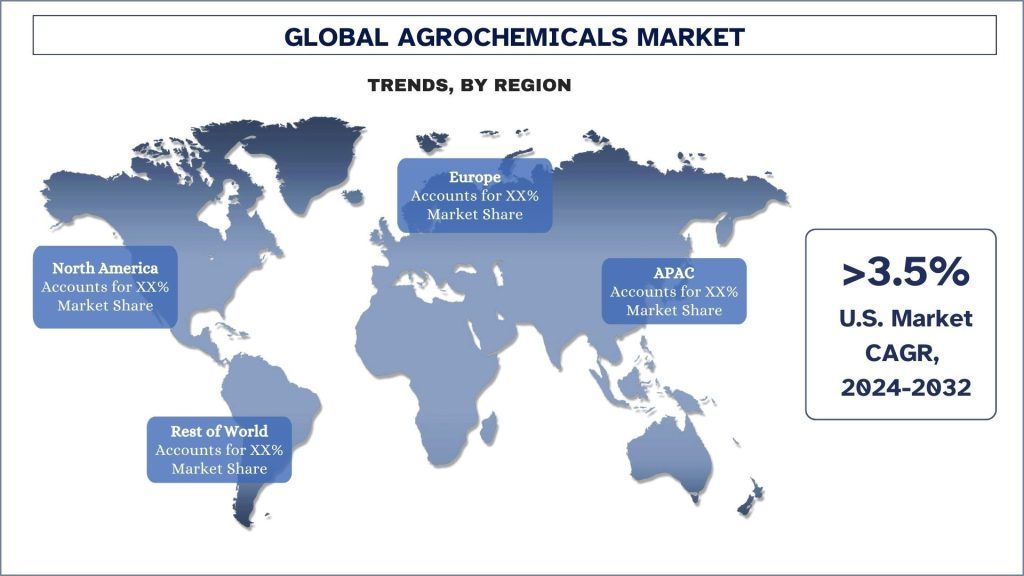
Agrochemicals Industry Overview
The Agrochemicals market is competitive, with several global and international players. The key players are adopting different growth strategies to enhance their market presence, such as partnerships, agreements, collaborations, new product launches, geographical expansions, and mergers and acquisitions. Some of the major players operating in the market are BASF SE, Bayer AG, Sumitomo Chemical Co., Ltd., Syngenta (ChemChina), Corteva (DowDuPont), UPL (United Phosphorus Limited), Yara, FMC Corporation, Nufarm, EuroChem Group.
Agrochemicals Market News
In January 2022, Syngenta Crop Protection acquired two next-generation bioinsecticides, NemaTrident and UniSpor®, to combat increasing resistance and a wide range of insects and pests across horticulture and ornamentals, turf amenities, and forestry, giving customers an even greater choice.
In November 2023– EuroChem-BMU completed pilot tests for the production of mineral NPS fertilizers with elemental sulfur. The first 4-kiloton batch of sulphur-containing fertilizers will be supplied to the Russian market. Sulfur-based products have proven their agrochemical efficiency in a series of field studies held in China and both North and Latin America.
02 December 2023, Akola: FMC India concluded a safety awareness program for the farming community in Akola district on using agrochemicals safely and judiciously, in partnership with the Agriculture Department of the Government of Maharashtra. The program educated Doctors in the district to recognize symptoms of agrochemical poisoning and treat chemical-exposed patients effectively.
Agrochemicals Market Report Coverage
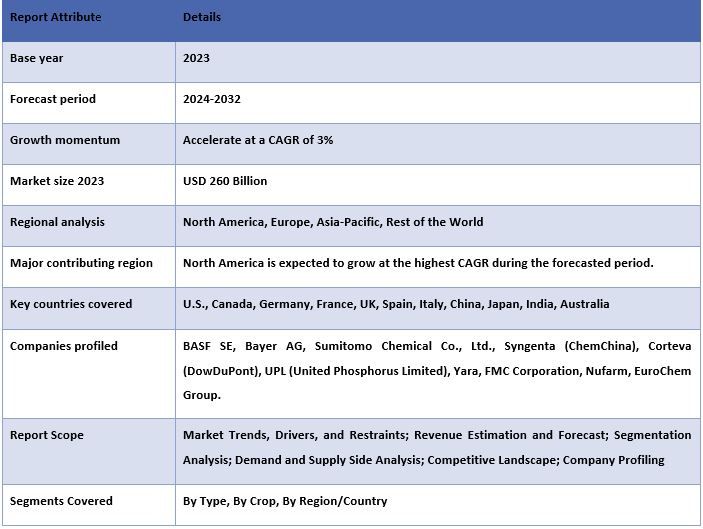
Reasons to buy this report:
- The study includes market sizing and forecasting analysis validated by authenticated key industry experts.
- The report presents a quick review of overall industry performance at one glance.
- The report covers an in-depth analysis of prominent industry peers with a primary focus on key business financials, product portfolios, expansion strategies, and recent developments.
- Detailed examination of drivers, restraints, key trends, and opportunities prevailing in the industry.
- The study comprehensively covers the market across different segments.
- Deep dive regional level analysis of the industry.
Customization Options:
The global Agrochemicals market can be customized further as per the requirement or any other market segment. Besides this, UMI understands that you may have your own business needs, hence feel free to connect with us to get a report that completely suits your requirements.
Table of Content
Research Methodology for the Agrochemicals Market Analysis (2022-2032)
Analyzing the historical market, estimating the current market, and forecasting the future market of the global Agrochemicals market were the three major steps undertaken to create and analyze the adoption of Agrochemicals in major regions globally. Exhaustive secondary research was conducted to collect the historical market numbers and estimate the current market size. Secondly, to validate these insights, numerous findings and assumptions were taken into consideration. Moreover, exhaustive primary interviews were also conducted, with industry experts across the value chain of the global Agrochemicals market. Post assumption and validation of market numbers through primary interviews, we employed a top-down/bottom-up approach to forecasting the complete market size. Thereafter, market breakdown and data triangulation methods were adopted to estimate and analyze the market size of segments and sub-segments of the industry. Detailed methodology is explained below:
Analysis of Historical Market Size
Step 1: In-Depth Study of Secondary Sources:
A detailed secondary study was conducted to obtain the historical market size of the Agrochemicals market through company internal sources such as annual reports & financial statements, performance presentations, press releases, etc., and external sources including journals, news & articles, government publications, competitor publications, sector reports, third-party database, and other credible publications.
Step 2: Market Segmentation:
After obtaining the historical market size of the Agrochemicals market, we conducted a detailed secondary analysis to gather historical market insights and share for different segments & sub-segments for major regions. Major segments are included in the report as type, crop, and region. Further country-level analyses were conducted to evaluate the overall adoption of testing models in that region.
Step 3: Factor Analysis:
After acquiring the historical market size of different segments and sub-segments, we conducted a detailed factor analysis to estimate the current market size of the Agrochemicals market. Further, we conducted factor analysis using dependent and independent variables such as type, crop, and regions of the Agrochemicals market. A thorough analysis was conducted for demand and supply-side scenarios considering top partnerships, mergers and acquisitions, business expansion, and product launches in the Agrochemicals market sector across the globe.
Current Market Size Estimate & Forecast
Current Market Sizing: Based on actionable insights from the above 3 steps, we arrived at the current market size, key players in the global Agrochemicals market, and market shares of the segments. All the required percentage shares split and market breakdowns were determined using the above-mentioned secondary approach and were verified through primary interviews.
Estimation & Forecasting: For market estimation and forecast, weights were assigned to different factors including drivers & trends, restraints, and opportunities available for the stakeholders. After analyzing these factors, relevant forecasting techniques i.e., the top-down/bottom-up approach were applied to arrive at the market forecast for 2032 for different segments and sub-segments across the major markets globally. The research methodology adopted to estimate the market size encompasses:
- The industry’s market size, in terms of revenue (USD) and the adoption rate of the Agrochemicals market across the major markets domestically
- All percentage shares, splits, and breakdowns of market segments and sub-segments
- Key players in the global Agrochemicals market in terms of products offered. Also, the growth strategies adopted by these players to compete in the fast-growing market
Market Size and Share Validation
Primary Research: In-depth interviews were conducted with the Key Opinion Leaders (KOLs) including Top Level Executives (CXO/VPs, Sales Head, Marketing Head, Operational Head, Regional Head, Country Head, etc.) across major regions. Primary research findings were then summarized, and statistical analysis was performed to prove the stated hypothesis. Inputs from primary research were consolidated with secondary findings, hence turning information into actionable insights.
Split of Primary Participants in Different Regions
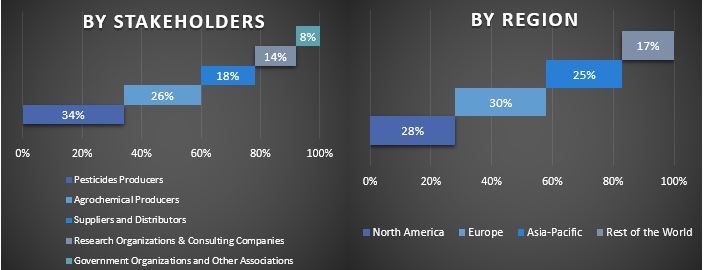
Market Engineering
The data triangulation technique was employed to complete the overall market estimation and to arrive at precise statistical numbers for each segment and sub-segment of the global Agrochemicals market. Data was split into several segments and sub-segments after studying various parameters and trends in the type, crop, and regions of the global Agrochemicals market.
The main objective of the Global Agrochemicals Market Study
The current & future market trends of the global Agrochemicals market were pinpointed in the study. Investors can gain strategic insights to base their discretion for investments on the qualitative and quantitative analysis performed in the study. Current and future market trends determined the overall attractiveness of the market at a regional level, providing a platform for the industrial participant to exploit the untapped market to benefit from a first-mover advantage. Other quantitative goals of the studies include:
- Analyze the current and forecast market size of the Agrochemicals market in terms of value (USD). Also, analyze the current and forecast market size of different segments and sub-segments.
- Segments in the study include areas of the type, crop, and regions.
- Define and analyze the regulatory framework for the Agrochemicals
- Analyze the value chain involved with the presence of various intermediaries, along with analyzing customer and competitor behaviors of the industry.
- Analyze the current and forecast market size of the Agrochemicals market for the major region.
- Major countries of regions studied in the report include Asia Pacific, Europe, North America, and the Rest of the World
- Company profiles of the Agrochemicals market and the growth strategies adopted by the market players to sustain the fast-growing market.
- Deep dive regional level analysis of the industry
Frequently Asked Questions FAQs
Q1: What is the Agrochemicals market's current size and growth potential?
Q2: What are the driving factors for the growth of the Agrochemicals market?
Q3: Which segment has the largest share of the Agrochemicals market by type?
Q4: What are the major trends in the Agrochemicals market?
Q5: Which region will dominate the Agrochemicals market?
Related Reports
Customers who bought this item also bought

